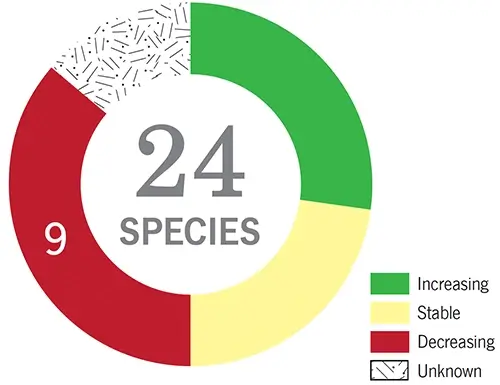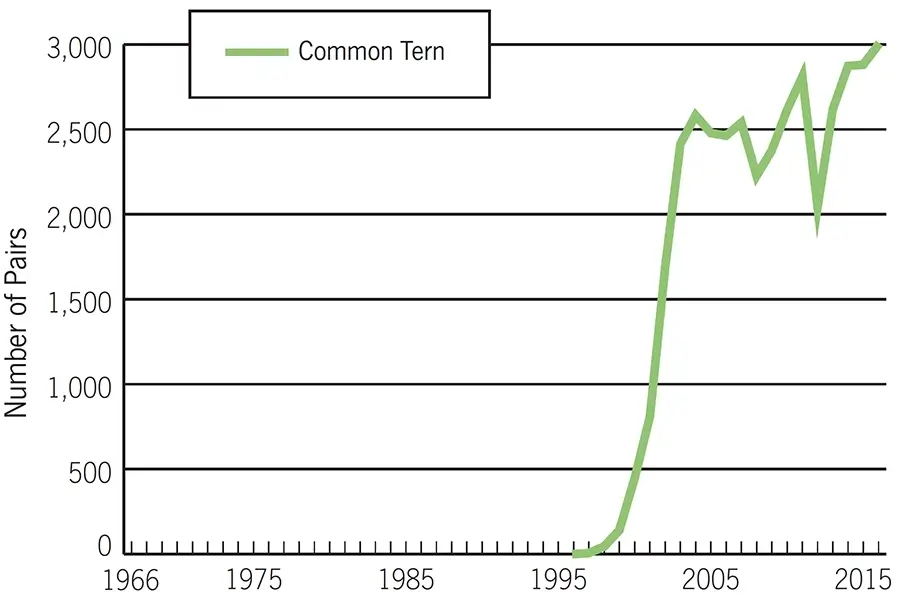New Hampshire’s coastline may be small, but it contains three habitats found nowhere else in the state: salt marsh, dunes, and coastal islands. Each supports a relatively small number of breeding species. Salt marsh, the most extensive of the three, occurs on the coast and inland along Great Bay, its tributary rivers, and upstream along the Salmon Falls River. It is home to three species of sparrows restricted to salt marshes. The state’s tiny remnant dune system is at Hampton and Seabrook beaches. This is the only place in New Hampshire where endangered Piping Plovers and Least Terns nest. Offshore islands, particularly the Isles of Shoals, are the primary nesting sites in the state for gulls, terns, and other marine birds.

Salt Marsh
American Black Duck
Willet
Common Tern
Purple Martin
Marsh Wren
Nelson’s Sparrow
Saltmarsh Sparrow
Beach and Dune
Piping Plover
Least Tern
Coastal Islands
Roseate Tern
Common Tern
Arctic Tern
Coastal habitats are also important for several SGCNs that do not breed in New Hampshire. See Birds and Migration in Winter for more detail.
Common Eider
Herring Gull
Double-crested Cormorant
Osprey

Across these three habitats, roughly half of coastal nesting birds are increasing or stable. The majority of these are the recipients of targeted conservation efforts over the last few decades (e.g., Piping Plover, Common Tern). Declining populations include Tree Swallow and Purple Martin, both aerial insectivores, and the salt marsh specialists Nelson’s and Saltmarsh Sparrows.
Beach goers and their dogs don’t mix well with dune-nesting birds. Interference with incubating birds and the feeding of young causes fewer young birds to survive. Birds of less accessible salt marshes and islands are generally less susceptible to this kind of stress.
Rising sea level from climate change threatens all the coastal habitats, and the potential for habitat to shift inland is limited by existing development. See the section on climate change for more information.
To ensure the continued presence of salt marsh birds in the state, efforts should focus on restoring degraded salt marshes and protecting those that are still intact. At the same time, we need to determine which areas of salt marsh are most likely to remain viable in the wake of projected rises in sea level induced by climate change and also identify and protect adjacent uplands that may become salt marsh with sea level rise. For dune-nesting species, key conservation actions include public education and restricted use areas to minimize human-bird interactions. Without the restricted use areas in Hampton and Seabrook, the state’s population of plovers would disappear within a couple of years. Continued human intervention to discourage predators and maintain nesting habitat also will be needed to maintain the tern colony at the Isles of Shoals.
Although more trend information on salt marsh birds is needed, actions should be taken now to protect what little remaining habitat exists. More information on threats to island nesting populations is needed to identify the best protective actions.
Many threats faced by birds are tied to the habitats where they breed. Explore the habitats and learn more about each one’s characteristics, population trends, threats, and conservation actions.
Contact Headquarters

National Wildlife Federation Affiliate
Website By CleverLight
Information for the species profiles on this website was compiled from a combination of the sources listed below.
The Birds of New Hampshire. By Allan R. Keith and Robert B. Fox. 2013. Memoirs of the Nuttall Ornithological club No. 19.
Atlas of the Breeding Birds of New Hampshire. Carol R. Foss, ed. 1994. Arcadia Publishing Company and Audubon Society of New Hampshire
Birds of the World. Various authors and dates. Cornell Laboratory of Ornithology.
Data from the Breeding Bird Survey
Data from the Christmas Bird Count